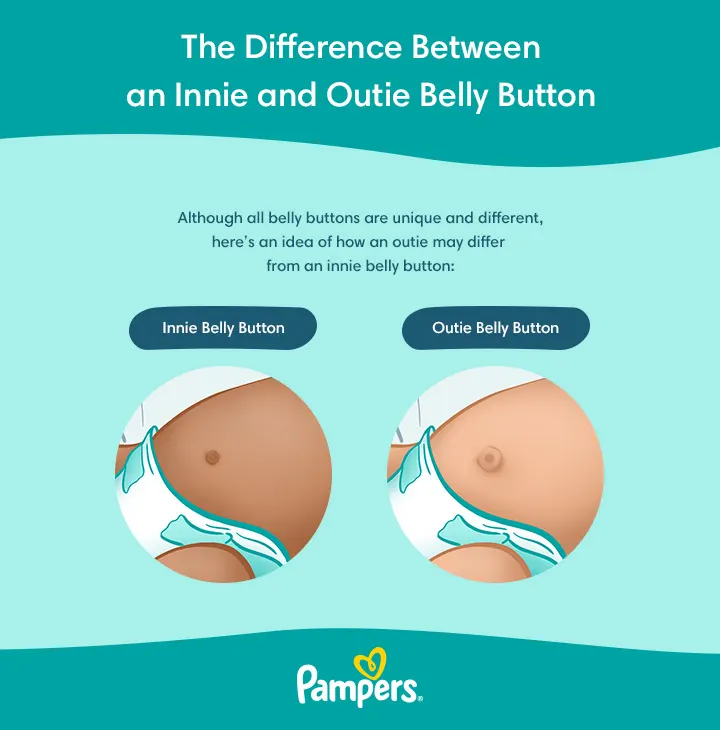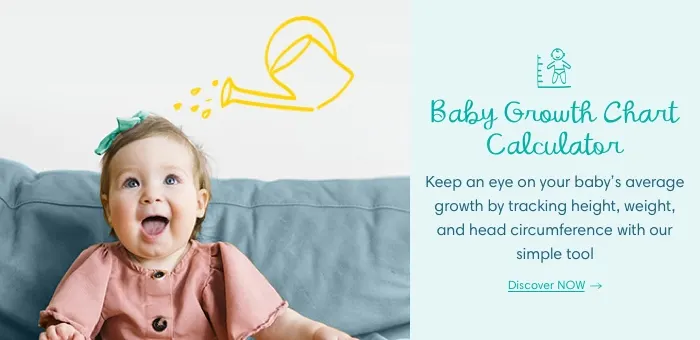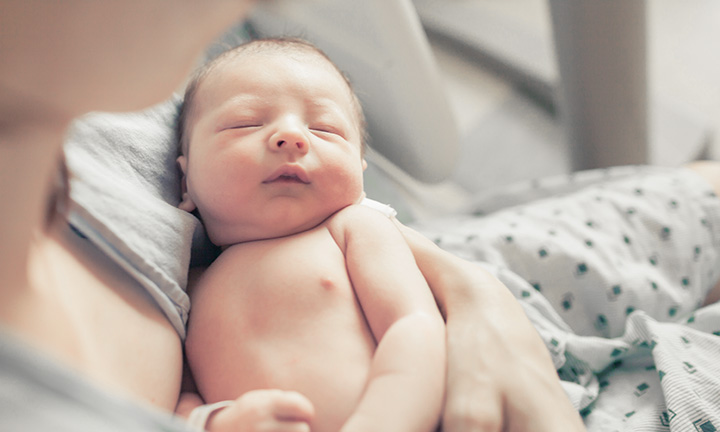- Newborn Baby
- Premature Babies
- Outie Belly Buttons in Babies?

What Causes an Outie Belly Button in Babies?
Key Takeaways
An ‘outie’ belly button is a normal variation that appears after the umbilical cord stump falls off. It’s simply less common than an ‘innie’ and usually nothing to worry about.
Most outies form based on how the cord heals. Sometimes, they’re linked to an umbilical hernia (a soft bulge that usually resolves by age 1–3) or an umbilical granuloma (a harmless red lump that’s easily treated).
Care is simple: keep the area clean and dry, use only water for early sponge baths, and avoid disturbing the healing site.
Don’t tape or push an outie inward. Most do not need treatment unless part of a medical condition.
See a doctor if you notice signs of infection, persistent bleeding or suspect a hernia or granuloma. These are usually easy to manage with proper care.
A baby's belly button is a captivating feature of their anatomy – and much like the little ones, belly buttons are distinctive and varied. You might have observed that your baby has either an ‘innie’ or an ‘outie belly button’. In this piece, we shall delve into the nature of an outie belly button, the cause of outie belly buttons, how to look after an outie belly button, and the appropriate time to reach out to your GP.
What’s an Outie Belly Button?
Let's begin by exploring the formation of belly buttons. The belly button – also known as the navel or umbilicus – is created at the point where the umbilical cord was previously connected. After birth, the cord is severed and taken away, leaving only a tiny stump behind, which typically dries up and drops off after around three weeks. As the area where the cord was heals on your baby's belly, the belly button comes into being.
An outie belly button is an informal, non-scientific term referring to a navel that protrudes outward, rather than being concave or inward-facing, called an innie belly button. So if your newborn belly button is sticking out, you can call your little one's adorable little belly button an outie.
Innie versus Outie Belly Button: What Determines the Difference?
The primary difference between an innie and an outie belly button lies in the way the umbilical cord heals and the appearance of the navel after the cord stump falls off. An innie belly button is concave, with the surrounding skin folding inward, while an outie belly button protrudes outward.
Remember, though outie belly buttons may be less common than innies, they’re just as cute and are nothing to be concerned about. In our section below, you can find more information on other conditions that may be mistaken for an outie belly button.

Baby Growth Chart Calculator
Keep an eye on your baby’s height, weight, and head circumference to average growth with our simple tool.
This is a mandatory field.
This is a mandatory field.
This is a mandatory field.
This is a mandatory field.
*Input details of your baby’s last measurements **Source: World Health Organization
What Causes an Outie Belly Button?
As mentioned above, a belly button is formed where the umbilical cord once was, after the stump falls off and the area heals. But why do some people have outies and others do not? It’s unclear exactly what causes an outie belly button, but it may have to do with the way the umbilical cord heals and detaches from your baby's belly button.
Although we've mentioned that an outie belly button is typically a natural occurrence, in some cases, it may be a result of certain medical conditions. An outie could form because of an umbilical hernia or an umbilical granuloma, generally harmless conditions but that should be looked into by your little one's GP.
Umbilical Hernia
An umbilical hernia in babies is a condition in which part of the intestine or fatty tissue bulges through a weak spot near the belly button (potentially causing the belly button to protrude). This hernia may look like a swelling or bulge and may be most evident when your little one cries or coughs. Most umbilical hernias close on their own within the first year or by the age of three. If you suspect your baby's belly button has an umbilical hernia or if they seem to be in pain, consult their GP for proper evaluation and management.
Umbilical Granuloma
An umbilical granuloma is a small, moist, red lump that can form on a baby's belly button after the umbilical cord stump falls off. It's a harmless overgrowth of scar tissue and usually occurs in the first few weeks after birth. If you notice your baby has an umbilical granuloma talk to your GP about treatment options, such as salt treatment that is easily performed at home. If it persists or causes any issues, consult your baby's GP.
Can an Outie Belly Button Become an Innie?
Parents often have questions about outie belly buttons, including can an outie belly button be fixed, and how to make an outie belly button go in naturally. A key point to remember is that each belly button is unique and that there isn’t just one type. And, in most cases, an outie belly button will not change into an innie as the child grows, and there's no medical need for it to do so.
However, if the outie belly button is due to an umbilical hernia, it may resolve on its own within the first few years of your child's life. If you have any questions or concerns about your baby's belly button, contact your baby's GP. Don't try to do anything on your own to try to make the umbilical hernia close or to change the appearance of your little one's belly button, as this will not help and may cause discomfort in your baby.
Related Articles
How to Care for Your Baby's Belly Button
Whether your little one has a tiny innie or outie belly button, you'll want to know how to care for it and keep it clean.
Provide sponge baths initially. Use water (and refrain from using alcohol) to delicately cleanse the region while you first bathe your newborn. A sponge bath (topping and tailing) is usually a preferred option in the first few weeks.
After the stump falls off, continue to keep the belly button area clean and dry until it heals – which may take a few days. Exposing it to air helps the healing process.
Once the stump is gone and the cord area heals, you can give your baby's belly button a regular bath in a tub. After you gently clean the belly button, dry it with a soft towel to avoid infections.
Keep an eye out for bleeding. Your child’s belly button might bleed a little when the tump falls off. A few drops of blood is normal. If it continues to bleed, contact your GP.
Read our helpful article for more information on how to care for your newborn’s umbilical cord.
When to Contact Your Doctor
As we mentioned above, an outie belly button is most often no cause for concern. However, if you observe any of the following, contact your baby's doctor.
Persistent bleeding following the detachment of the umbilical stump.
Signs of infection in the area, such as yellow discharge, a foul smell, or redness and swelling around your baby’s belly button.
Signs of an umbilical hernia.
Indicators of an Umbilical Granuloma.
FAQS AT A GLANCE
Yes, it's perfectly okay to have an outie belly button. Both ‘innie’ and ‘outie’ belly buttons are normal variations of a belly button's appearance. An outie belly button is typically the result of how the umbilical cord was attached and how it healed after birth, and it doesn't usually indicate any health issues.
Outie belly buttons are less common than innies. While exact statistics may vary, it's generally believed that a smaller percentage of the population has an outie belly button. The rarity is due to the natural variation in how umbilical cords heal and close after birth.
An outie belly button is a natural occurrence and doesn’t generally need medical attention.
However, if it’s caused by an umbilical hernia or granuloma, it’s best to consult your GP. Both typically resolve on their own or with minimal treatment.
An outie belly button can sometimes become an innie belly button as a child grows and their abdominal muscles develop. But keep in mind that each little belly button is unique and adorable – just like your baby. Trying to make an outie belly button become an innie could be unsafe for your little one.
It's not advisable to attempt to push an outie belly button back in, as this could cause harm or discomfort. The shape of a belly button, whether an innie or outie, is determined by how the umbilical cord was attached and healed after birth. If you’re concerned about your baby’s belly button or if it’s causing them discomfort, it's best to consult with a GP for appropriate advice or treatment options.
The Bottom Line
Outie belly buttons in babies are a normal variation in appearance and usually do not require any special care. By keeping the area clean and dry and watching for any signs of infection or discomfort, you can ensure your baby's belly button remains healthy and simply adorable.
If you have some spare time today, download the Pampers Club app to get rewards on all those nappies your baby's belly button is going through.
How We Wrote This Article The information in this article is based on expert advice found in trusted medical and government sources, such as the National Health Service (NHS). You can find a full list of sources used for this article below. The content on this page should not replace professional medical advice. Always consult medical professionals for full diagnosis and treatment.
Read more about Newborn Baby
Join Pampers Club and get:





